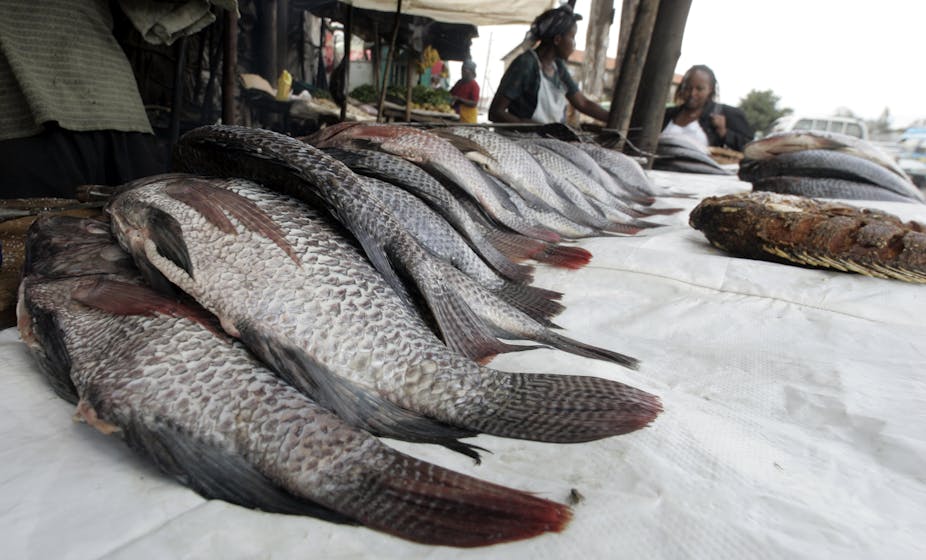Tanzania is rich in exciting wildlife that has helped make it a thriving tourist destination. But some of its less photogenic species could also play an important role in the country’s economic development.
In the beautiful setting of Zanzibar it’s easy to forget that around a third of Tanzanian children under five are stunted due to malnutrition. One in ten women are also undernourished. They are more likely to give birth to underweight infants, perpetuating the impact of undernutrition down the generations.
Population growth is increasing demand for animal protein. Fish and fisheries products can provide a valuable source of protein, as well as essential micronutrients for balanced nutrition and health. But domestic production is unable to keep pace. So imports are filling the gap. Between 2010 and 2013 imports of fish and fishery products increased by 240%.
Worldwide, aquaculture – the farming of plants, algae (for instance, seaweed), and animals in aquatic environments – grows faster than any other food-production sector. This is often referred to as a blue revolution. In Africa, the industry is growing by 11.7% every year. But 90% of that growth is in just two countries – Egypt and Nigeria.
In Tanzania, aquaculture is still largely a small-scale rural initiative. It is characterised by small pond culture and contributes only 1.4% to GDP. There is much greater potential.
Inland water covers about 6.5% of the total land area, including the Great Lakes –- Lake Victoria, Tanganyika and Nyasa/Malawi. The lakes are recognised as one of only 25 biodiversity hotspots in the world because they are home to hundreds of species of cichlid fish. These include around 30 species of tilapia, 11 of which are not found anywhere else on earth.
The Earlham Institute and Bangor University, as part of an international consortium of organisations, are working to characterise the genetics of tilapia species in Tanzania. The larger consortium includes the Earlham Institute, Bangor University, the Swedish University of Agricultural Sciences, WorldFish, the University of Dar es Salaam, Sokoine University of Agriculture, and the Tanzanian Fisheries Research Institute. The aim is to improve aquaculture and fish production, while preserving Tanzania’s natural diversity and resources.
Farming tilapia
Tilapia are particularly suitable for aquaculture because they are able to tolerate different environments and conditions. Their growth rates are also relatively fast, and they have low system input requirements. They’re second only to carp as the world’s most frequently farmed fish.
To help harness this potential, the consortium received funding from the Swedish “Agriculture for Food Security 2030” (AgriFoSe) and the Swedish University of Agricultural Sciences. The participation of scientists from Bangor University and Earlham Institute was supported by a BBSRC award from the Global Challenges Research Fund to bring together Tanzanian scientists, fish farmers and government officers with experts from around the world.
Last year the consortium drew up a resolution to establish a National Aquaculture Development Centre in Tanzania. The centre could help triple the contribution that aquaculture makes to the economy, double the production of fish in the country by 2025 and help improve access to fish as a protein source for those most vulnerable to undernutrition.
The Ministry of Agriculture Livestock and Fisheries welcomed the centre’s input on developing new policy briefs that could help make the goals a reality.
As one of the partners the Earlham Institute, in close collaboration with Bangor University, can provide access to some of the most advanced sequencing technology in the world and training in how to apply it. This technology allows for the rapid identification of tilapia species that are responsible for traits of commercial importance, such as good growth rate and efficient use of feed.
The insitute can help characterise the diversity of wild tilapia species found in the country’s lakes, rivers, dams and wetlands. This analysis helps to identify which species have valuable traits for developing new breeding stock.
By developing broodstock from native tilapia, Tanzania has the potential to develop an independent industry. This would be based on its own supply of fingerlings (young fish), rather than relying solely on non-native species. In the 1980s Oreochromis niloticus (Nile tilapia) and Lates niloticus (Nile perch) were introduced to boost fisheries in Lake Victoria. Indigenous tilapia species declined to extremely low levels or vanished from the lake altogether.
A Tanzanian aquaculture seed bank could be valuable for breeders worldwide, for example by offering strains adapted to harsh environments.
New smartphone app
With Bangor University and software development partners Geosho, we are also developing a new way to track invasive species. A new smartphone app, “TilapiaMap”, can be used to help identify tilapia species in the field and map the distribution of recorded species. It could help highlight regions rich in pure species, where conservation measures could be put in place. It could also flag regions with a high number of hybrids that pose a biosecurity risk.
In this way, we hope to help preserve the natural biodiversity on which an independent industry could be built. This could make a real contribution to food security and could continue to supply novel traits for breeding into the future.

